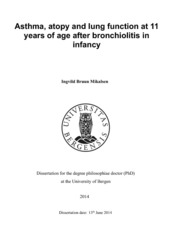| dc.contributor.author | Mikalsen, Ingvild Bruun | en_US |
| dc.date.accessioned | 2014-06-30T13:17:42Z | |
| dc.date.available | 2014-06-30T13:17:42Z | |
| dc.date.issued | 2014-06-13 | eng |
| dc.identifier.isbn | 978-82-308-2887-8 | en_US |
| dc.identifier.uri | https://hdl.handle.net/1956/8038 | |
| dc.description.abstract | Background: Bronchiolitis is a frequently occurring respiratory disorder in young children, and also an established risk factor for subsequent recurrent wheeze and asthma. The association between bronchiolitis and later asthma is complex and not fully understood, and probably related to interactions between viral aetiology, various host factors and environmental mechanisms. Few long-term follow-up studies have included children hospitalized for bronchiolitis below 12 months of age with Respiratory syncytial virus (RSV) positive as well as RSV negative disease. Aim: The overall aim of this thesis was to study the prevalence of asthma and atopy, and the respiratory function at 11 years of age after hospitalization for bronchiolitis in infancy, in order to contribute to the understanding of the pathophysiological and clinical outcomes after bronchiolitis. Methods: A prospective observational and partly controlled cohort design was applied. One hundred and thirty one children hospitalized for bronchiolitis during their first year of life were enrolled. Markers of eosinophilic airway inflammatory were measured in urine and blood in 105 children at hospitalization. At two years of age parents of 101 children filled in questionnaires, and a skin prick test (SPT) was performed. The second follow-up at 11 years of age included 121 children from the post-bronchiolitis group and a control group of 141 children. All parents answered a questionnaire regarding respiratory symptoms of the child, and assessment of lung function, exhaled nitric oxide (FeNO), bronchial hyperresponsiveness (BHR) and a SPT were performed. Results: Children hospitalized with bronchiolitis in infancy had an increased risk of subsequent asthma, reduced lung function and higher BHR, but not an increased risk of atopy at 11 years of age. After stratifying for viral aetiology (RSV+/RSV-) and gender, higher prevalence of asthma and an obstructive lung function pattern was only present in children with a history of RSV negative bronchiolitis. Higher BHR was confined to boys, irrespective of viral aetiology. Blood eosinophil counts measured during bronchiolitis in infancy were higher in children with current asthma than those without asthma at 11 years of age. Blood eosinophil counts during bronchiolitis were associated with reduced lung function and higher BHR at 11 years of age. FeNO did not differ between the post-bronchiolitis and control group at 11 years of age. FeNO was associated with atopy, but not asthma in children hospitalized for bronchiolitis as well as in the control group. Prediction of asthma at 11 years of age based on a model including clinical parameters available at two years of age proved to be challenging, but was as good as more complex models including invasive tests. However, the model did predict the absence of asthma reasonably well, with low negative post-test probabilities. Conclusions Severe bronchiolitis in infancy was associated with long-term pulmonary features such as asthma, airway obstruction and BHR. These associations seemed to be modulated by viral aetiology and possibly also by aspects of the inflammatory response pattern during the acute episode. Clinical parameters available at two years of age were better to predict the absence than the presence of asthma at 11 years. The understanding of the pathophysiology and the long-term outcomes of bronchiolitis is still fragmented, and further studies including large cohorts of subjects preferably representing entire geographic regions should ideally be followed from birth to adulthood, including well selected control subjects. | en_US |
| dc.language.iso | eng | eng |
| dc.publisher | The University of Bergen | eng |
| dc.relation.haspart | Paper I: Mikalsen IB, Halvorsen T, Øymar K. The outcome after severe bronchiolitis is related to gender and virus. Pediatr Allergy Immunol. 2012; 23: 391-98. The article is not available in BORA due to publisher restrictions. The published version is available at: <a href="http://dx.doi.org/10.1111/j.1399-3038.2012.01283.x" target="blank"> http://dx.doi.org/10.1111/j.1399-3038.2012.01283.x</a> | en_US |
| dc.relation.haspart | Paper II: Mikalsen IB, Halvorsen T, Øymar K. Blood eosinophil counts during bronchiolitis are related to bronchial hyperresponsiveness and lung function in early adolescence. Acta Paediatr. 2014; 103: 86-92. The article is not available in BORA due to publisher restrictions. The published version is available at: <a href="http://dx.doi.org/10.1111/apa.12432" target="blank">http://dx.doi.org/10.1111/apa.12432</a> | en_US |
| dc.relation.haspart | Paper III: Mikalsen IB, Halvorsen T, Øymar K. Exhaled nitric oxide is related to atopy, but not asthma in adolescents with bronchiolitis in infancy. BMC Pulm Med. 2013; 13: 66. The article is available at: <a href="http://hdl.handle.net/1956/8037" target="blank">http://hdl.handle.net/1956/8037</a> | en_US |
| dc.relation.haspart | Paper IV: Mikalsen IB, Halvorsen T, Eide GE, Øymar K. Severe bronchiolitis in infancy: Can asthma in adolescence be predicted? Pediatr Pulmonol. 2013; 48: 538-44. The article is not available in BORA due to publisher restrictions. The published version is available at: <a href="http://dx.doi.org/10.1002/ppul.22675" target="blank">http://dx.doi.org/10.1002/ppul.22675</a> | en_US |
| dc.title | Asthma, atopy and lung function at 11 years of age after bronchiolitis in infancy | en_US |
| dc.type | Doctoral thesis | |
| dc.rights.holder | Copyright the author. All rights reserved | |
| dc.identifier.cristin | 1136156 | |
